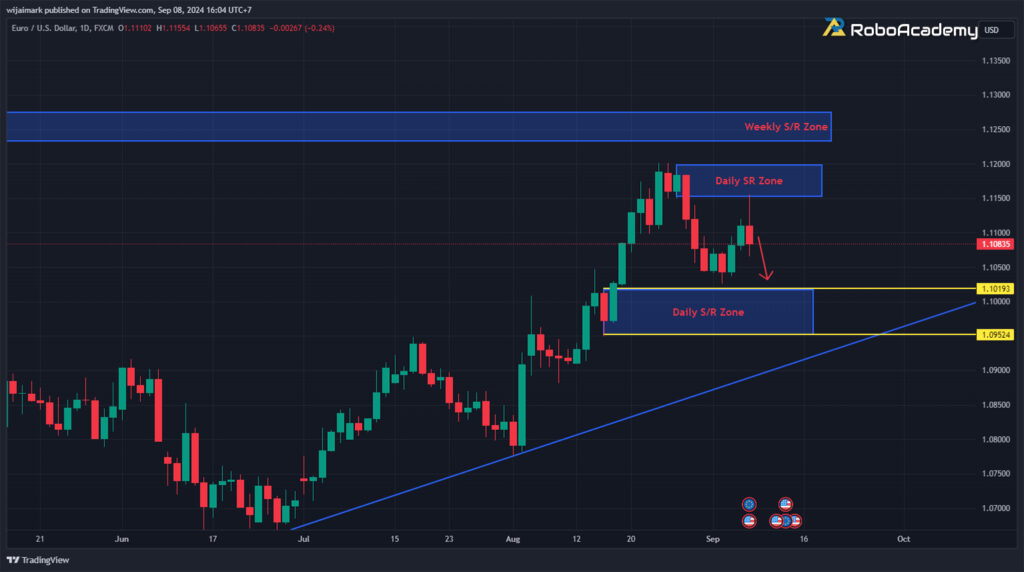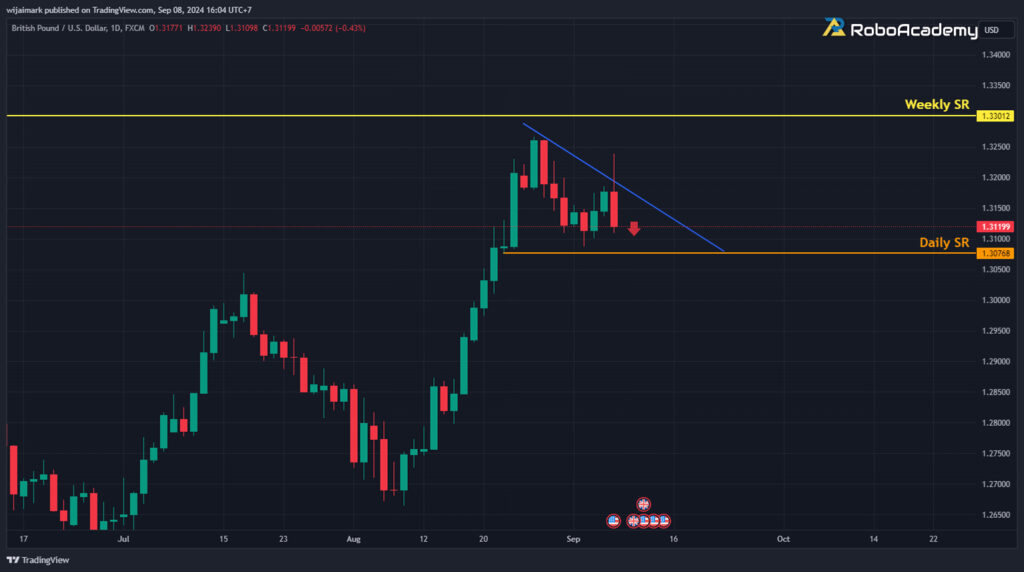Fundamental & Technical Analysis by Coach Mark RoboAcademy during 9 – 13 September 2024
Hello everyone, welcome to the weekly analysis of currency pairs EUR/USD, GBP/USD, and XAU/USD for the second week of September, from 9 – 13 September 2024.
EUR/USD, “Euro vs US Dollar”

Fundamental Analysis
Significant Economic Events Impacting EUR/USD This Week:
European Economic Data:
- ECB Interest Rate Decision (September 12): The European Central Bank (ECB) is scheduled to announce its decision regarding interest rates. If the ECB decides to raise interest rates to control inflation, the euro could strengthen against the US dollar. On the other hand, if the ECB keeps rates unchanged or signals a dovish outlook, the euro may weaken.
- Various Economic Data from the Eurozone, such as Industrial Production and Trade Balance: Stronger-than-expected data may support the euro, while weaker-than-expected data could pressure the currency.
U.S. Economic Data:
- Inflation Data (September 12): The U.S. Consumer Price Index (CPI) will be released. If inflation is higher than expected, it may raise expectations for additional interest rate hikes by the Federal Reserve (Fed), which would support the U.S. dollar. Conversely, if inflation is lower than expected, it could reduce the likelihood of further rate hikes, potentially weakening the dollar.
- Retail Sales Data (September 13): This will provide insight into consumer spending, a key driver of economic growth. Strong retail sales could strengthen the U.S. dollar, while weak sales may lead to dollar depreciation.
Technical Analysis
The price remains within the previous range. Most recently, after Friday’s Non-Farm Payrolls announcement, the price initially moved up due to the weaker-than-expected U.S. data. However, shortly before the market closed, the price dropped sharply.
It’s expected that the price may test the support zone around 1.10193, with a focus on the monetary policy stance from Europe. If there is an interest rate adjustment, it will directly impact this currency pair.
It’s recommended to wait for the interest rate news to be released and observe the price action to determine the direction before entering a trade.
GBP/USD, “Great Britain Pound vs US Dollar”

Fundamental Analysis
Significant Economic Events Impacting GBP/USD This Week:
U.K. Economic Data:
- Key Economic Reports from the UK, such as GDP growth, industrial production, and trade balance: If these figures are strong, they may boost confidence in the UK economy and support the British pound. On the other hand, weaker-than-expected data could put pressure on the currency.
U.S. Economic Data:
- U.S. Inflation (CPI) and Retail Sales Data: These will be released on September 12 and 13, respectively. If inflation is higher than expected or retail sales are strong, it could boost the U.S. dollar, putting pressure on GBP/USD. Conversely, if the data comes in lower than expected, the U.S. dollar could weaken, benefiting the GBP/USD pair.
Technical Analysis
The price movement has been similar to EURUSD. Last Friday, the price initially moved up in response to weaker U.S. data, but it then sharply dropped back down.
It’s expected that the price may test the support level at 1.30768. After that, it will be important to see which direction the price takes. It might be more prudent to wait for a break below the support level, followed by a retest, to ensure a more reliable entry point.
XAU/USD, “Gold vs US Dollar”

Fundamental Analysis
Significant Economic Events Impacting XAU/USD This Week:
Economic Data Related to Gold:
- Inflation Data (September 12): The U.S. Consumer Price Index (CPI) announcement will be highly significant. If inflation is higher than expected, it may raise expectations for further interest rate hikes by the Federal Reserve (Fed), which could pressure gold prices. Higher interest rates increase the opportunity cost of holding non-yielding assets like gold. Conversely, if inflation is lower than expected, it may support gold prices, as the Fed could adopt a more cautious approach.
- Retail Sales Data (September 13): This will provide insight into consumer spending, a key driver of economic growth. Strong retail sales may strengthen the U.S. dollar, potentially leading to a decline in gold prices. On the other hand, weaker retail sales could lower expectations for additional rate hikes, supporting gold prices.
- Central Bank Activity: Unexpected comments or actions from central banks, particularly the Fed and the European Central Bank (ECB), could impact gold prices. If there are hawkish signals regarding monetary policy, it may pressure gold, while dovish signals could support gold prices.
Technical Analysis
Following last Friday’s Non-Farm Payrolls announcement, it became clear that there is a very strong resistance zone around 2525-2530. Despite weaker-than-expected U.S. data, gold was unable to reach its all-time high (ATH) and sharply dropped back down.
It is expected that the price may move sideways within a larger range, as shown in the chart. For now, a strategy of buying at support and selling at resistance within this range could be applied, since the price hasn’t chosen a direction yet.
Disclaimer: This article is solely an analysis from the coach at RoboAcademy and is not intended as investment advice in any way. Investing is risky. Investors should study the information before making investment decisions.


